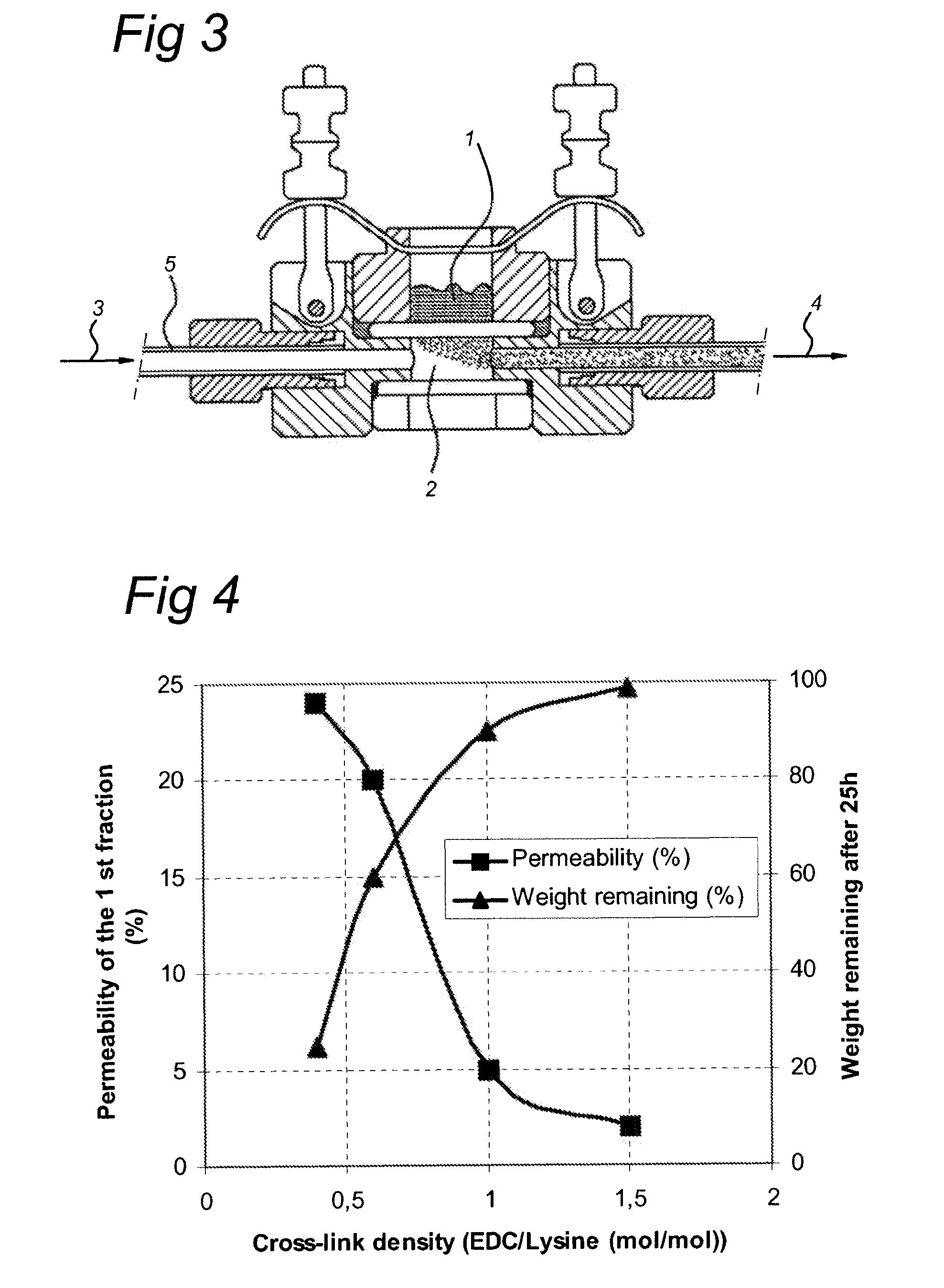Non-porous film for culturing cells
a non-porous film and cell technology, applied in the field of gelatin comprising films, can solve the problems of contact between fibroblast and keratinocyte layers, and achieve the effect of preventing cracking or breaking of the film, fast drying and preventing the film from cracking or breaking
- Summary
- Abstract
- Description
- Claims
- Application Information
AI Technical Summary
Benefits of technology
Problems solved by technology
Method used
Image
Examples
example 1
Preparation of Nonporous Film from a Recombinantly Produced Tetramer of 72.6 Kilo Dalton as Described in EP-A-1398324
[0101]Totally 11.4 g of the tetramer was dissolved in 34.2 g demineralized water at 40 degrees Celsius. After dissolving, the temperature was increased to 60 degrees Celsius for 30 minutes and then decreased again to 40 degrees Celsius. Additional 11.4 g EtOH (96% pure) was added. pH of the solution was adjusted with 1M NaOH to 7.5.
[0102]25% EDC(N-Ethyl-N′-(3-Dimethyl aminopropyl)carbodiimide.HCl) solution was prepared by dissolving 1 g EDC in 3 g demineralized water.
[0103]Additions of the crosslinking compound solution to the collagenous polypeptide solutions were done according table 1. After addition the mixtures were stirred thoroughly and the mixtures were applied on non-treated photographic base-paper with a polyethylene top layer. With a spirally wound ‘Large K Hand Coater Bar’ No. 125 a wet film deposit of 125 μm was coated on A4 sized substrates. The coated f...
example 2
In Vitro Degradation of the Cross-Linked Membranes
[0122]Bacterial collagenase (activity of >125 CDU / mg (One Collagen Digestion Unit liberates peptides from collagen equivalent in ninhydrin color to 1.0 μmole of leucine in 5 hr at pH 7.4 at 37° C. in the presence of calcium ions)) from Clostridium histolyticum (Sigma-Aldrich, EC 3.4.24.3) was selected as an enzyme for the degradation studies because of its specificity for collagen. These collagenase preparations contain at least six different collagenases which are capable of cleaving peptide bonds within the triple helical structure and have a specificity for the Pro-X-Gly-Pro-Y region, splitting between X and Gly.
[0123]In a typical degradation experiment, a 10 milligram sample of cross-linked collagenous polypeptide with either GTA or EDC is immersed in 0.5 ml of a 0.1 M Tris-HCl buffer solution (pH 7.4) containing 0.005M CaCl2 and 0.05 mg / ml sodium azide and incubated at 37° C. After one hour, 0.5 ml collagenase solution in Tris-H...
example 3
Permeability and Degradation Level vs. Cross-Link Density
[0128]To determine the permeability of the prepared membranes a diffusion experiment was initiated. 193 mg of Lysozyme, a globular protein of 14.3 kDa, was dissolved in 5 ml physiological salt solution to obtain a lysozyme concentration of 38.6 mg / ml (donor solution).
[0129]The EDC cross-linked gelatin membranes with a cross-linking density of 0.4, 0.6, 1.0 and 1.5 EDC / lysine (mol / mol) were mounted in the diffusion cells (see FIG. 3) and 300 μl of the donor solution was put on top of the mounted membranes.
[0130]The receptor fluid (also physiological salt solution) flow is 1 ml / hr. During the whole experiment the temperature of the system was kept at 37° C.
[0131]The first fraction of 5 ml and the diluted donor solution were analyzed by means of GPC at a wavelength of 280 nm.
[0132]The results were compared to the degradation level (weight remaining %) after 25 h. See FIG. 4 for the graphical presentation of the data which show th...
PUM
| Property | Measurement | Unit |
|---|---|---|
| pore size | aaaaa | aaaaa |
| pore size | aaaaa | aaaaa |
| pore-size | aaaaa | aaaaa |
Abstract
Description
Claims
Application Information
 Login to View More
Login to View More - R&D
- Intellectual Property
- Life Sciences
- Materials
- Tech Scout
- Unparalleled Data Quality
- Higher Quality Content
- 60% Fewer Hallucinations
Browse by: Latest US Patents, China's latest patents, Technical Efficacy Thesaurus, Application Domain, Technology Topic, Popular Technical Reports.
© 2025 PatSnap. All rights reserved.Legal|Privacy policy|Modern Slavery Act Transparency Statement|Sitemap|About US| Contact US: help@patsnap.com


